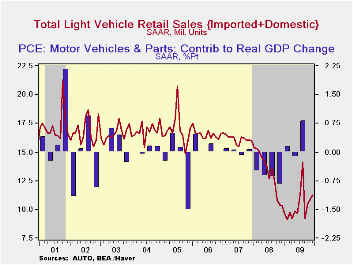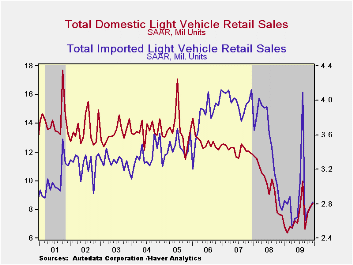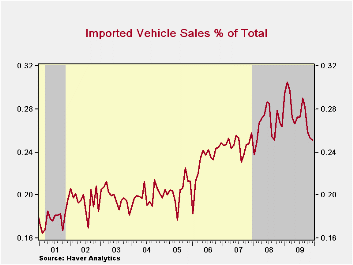 Global| Jan 06 2010
Global| Jan 06 2010U.S. Vehicle Sales Improve At YearendBut For 2009 Were The Lowest In Twenty Seven Years
by:Tom Moeller
|in:Economy in Brief
Summary
U.S. unit sales of light vehicles during December recovered slightly, but by hardly enough to salvage losses earlier in the year. Sales rose 2.9% m/m to 11.25M units according to the Autodata Corporation and were slightly stronger [...]
 U.S.
unit sales of light vehicles during December
recovered slightly, but by hardly enough to salvage losses earlier in
the year. Sales rose 2.9% m/m to 11.25M units according to the Autodata
Corporation and were slightly stronger than Consensus expectations for
11.0M. To the upside, December sales rose 22.7% from the February '09
low. For the year as a whole, however, sales fell 21.6% from the 2008
average. At 10.37M units vehicle purchases last year were at their
lowest level since 1982. (Seasonal adjustment of these figures is
provided by the U.S. Bureau of Economic Analysis).
U.S.
unit sales of light vehicles during December
recovered slightly, but by hardly enough to salvage losses earlier in
the year. Sales rose 2.9% m/m to 11.25M units according to the Autodata
Corporation and were slightly stronger than Consensus expectations for
11.0M. To the upside, December sales rose 22.7% from the February '09
low. For the year as a whole, however, sales fell 21.6% from the 2008
average. At 10.37M units vehicle purchases last year were at their
lowest level since 1982. (Seasonal adjustment of these figures is
provided by the U.S. Bureau of Economic Analysis).
Sales of domestically made vehicles rose 3.1% last month to 8.42M units. They now have recovered by nearly one-third from the February low but for the year as a whole fell by nearly one-quarter from 2008. Sales of fuel efficient cars rose 9.1% for the month and have risen by nearly one-half from the January low. For the year as a whole sales fell 19.8%. Light truck sales slipped 2.0% m/m during December but were 25.8% above the low. For 2009, sales fell 25.2% as gasoline prices rose.
Imported light vehicle sales rose 2.4% from November to 2.82M and were up 12.4% from the recession low in April. For 2009 sales fell a lesser 18.3% from the 2008 average. Sales of imported autos inched up another 0.8% m/m and 12.1% from the low. Sales for 2009 were 18.2% below 2008 while imported light truck sales rose 5.8% during December and by 12.9% from the low. For all of 2009 imported light trick sales fell 18.5%.
Overall, import's share of the U.S. light vehicle market during December was roughly stable m/m at 25.1%. It reached a new high of 27.6% during all of last year versus 26.5% during 2008. (Imported vehicles are those produced outside the United States.) Imports' share of the U.S. car market totaled 31.5% versus 34.3% during all of last year, which was up just slightly from 2008, while the share of the light truck market was 17.8%, down from 19.6% last year and from 18.3% in 2008.
The U.S. vehicle sales figures can be found in Haver's USECON database.
Automotive Industry Outlook: Understanding the Impact on Workers and Communities from the Federal Reserve Bank of Chicago can be found here.


| Light Vehicle Sales (SAAR, Mil. Units) | December | November | October | Dec. Y/Y | 2009 | 2008 | 2007 |
|---|---|---|---|---|---|---|---|
| Total | 11.25 | 10.93 | 10.46 | 8.7% | 10.37 | 13.22 | 16.16 |
| Autos | 6.01 | 5.65 | 5.50 | 13.9 | 5.46 | 6.76 | 7.58 |
| Domestic | 4.11 | 3.77 | 3.64 | 15.8 | 3.56 | 4.44 | 5.06 |
| Imported | 1.89 | 1.88 | 1.87 | 10.1 | 1.90 | 2.32 | 2.52 |
| Light Trucks | 5.24 | 5.28 | 4.96 | 0.2 | 4.91 | 6.46 | 8.60 |
| Domestic | 4.31 | 4.40 | 4.12 | 2.6 | 3.95 | 5.28 | 7.10 |
| Imported | 0.93 | 0.88 | 0.84 | -10.3 | 0.96 | 1.18 | 1.47 |
Tom Moeller
AuthorMore in Author Profile »Prior to joining Haver Analytics in 2000, Mr. Moeller worked as the Economist at Chancellor Capital Management from 1985 to 1999. There, he developed comprehensive economic forecasts and interpreted economic data for equity and fixed income portfolio managers. Also at Chancellor, Mr. Moeller worked as an equity analyst and was responsible for researching and rating companies in the economically sensitive automobile and housing industries for investment in Chancellor’s equity portfolio. Prior to joining Chancellor, Mr. Moeller was an Economist at Citibank from 1979 to 1984. He also analyzed pricing behavior in the metals industry for the Council on Wage and Price Stability in Washington, D.C. In 1999, Mr. Moeller received the award for most accurate forecast from the Forecasters' Club of New York. From 1990 to 1992 he was President of the New York Association for Business Economists. Mr. Moeller earned an M.B.A. in Finance from Fordham University, where he graduated in 1987. He holds a Bachelor of Arts in Economics from George Washington University.






